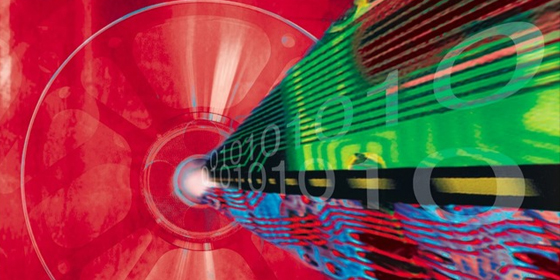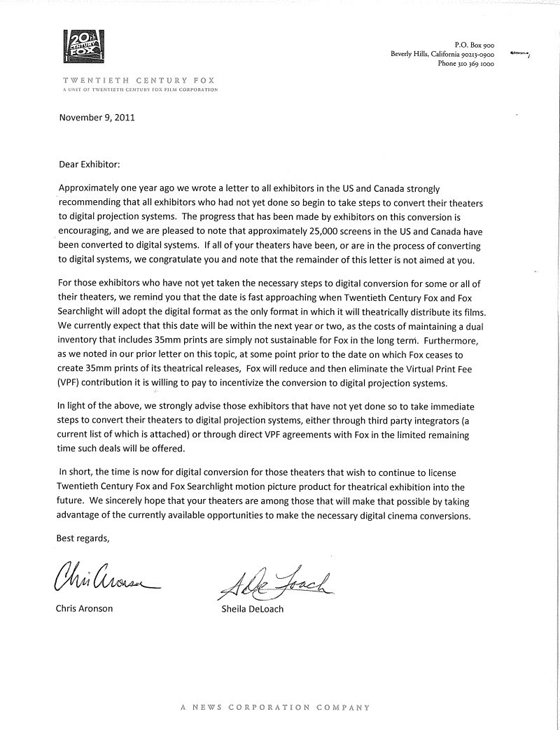The end of the analogue processes that have been with cinema since the 1890s is now in sight.
Regular readers of this site will know that a revolution has been taking place in projection rooms around the world.
Over the last few years, multiplex and arthouse cinemas in the US and UK have been switching to digital projection rather than shining light through celluloid.
But because many audience members don’t notice a discernible difference, it perhaps gets less press coverage than it should.
Make no mistake we are now firmly in the digital era and the old analogue one is about to expire.
How soon?
Last November Fox Searchlight, one of the major suppliers to US independent cinemas, wrote a letter saying they would stop supplying 35mm prints ‘within 18 months’.
By my estimate, that’s a Spring 2013 deadline.
After that costs will exponentially rise as the ‘analogue film market’ (i.e. celluloid prints shipped to cinemas and threaded through a projector) will essentially expire, apart from a rarefied circle of specialised institutions.
But how long before the other major US indie distributors – such as Focus Features, Sony Pictures, The Weinstein Company – begin to stop sending out 35mm prints of their movies?
If they aren’t already, I suspect it will be sooner rather than later.
For the past several years the major studios have long wanted to make the jump to digital because of the cost savings.
Getting exhibitors on board was tricky as the digital upgrade was a costly process which still needed the battering ram of Avatar (2009) to convince sceptical cinemas.
Ironically, some independent chains embraced digital before multiplexes and helped form the DCI standard (Digital Cinema Initiatives).
Projection had to be at least 2K resolution, the file format was JPEG2000, and a key system was designed to prevent piracy by authenticating screenings to the projectors authorized to show it.
To help fund this transition the studios helped subsidise exhibitors with what is known as a Virtual Print Fee.
This made the transition smoother than it might have been and allowed them to make long term savings on shipping digital cinema prints (instead of cans of celluloid) and screening 3D movies.
Just because the air has seemingly come out of the 3D balloon doesn’t mean there is any rolling back the wider digital revolution.
The enormous success of Avatar and Alice in Wonderland – which both earned the bulk of their money in early 2010 – convinced studios that 3D was the future in which they could charge higher ticket prices.
That reality hasn’t come to pass mainly due to the inherent limitations of the current version of 3D (still too dim) but it was the tipping point which helped persuade reluctant exhibitors to adopt digital projection systems.
But it is not the multiplex chains who will be affected in the short term but independent cinemas, for if they can’t get access to archive film prints then they will go out of business.
This is why head of John Fithian, head of the umbrella group NATO (North American Theater Owners), said last year at CinemaCon:
“I believe that film prints could be unavailable as early as the end of 2013. Simply put, if you don’t make the decision to get on the digital train soon, you will be making the decision to get out of the business.”
In their 2007 study titled The Digital Dilemma, the Academy found the cost of storing 4K digital masters to be:
“enormously higher – 1100% higher – than the cost of storing film masters.”
This report was something John Bailey talked about when he spoke at CineGear Expo last year:
Earlier this January the Academy published the sequel, The Digital Dilemma 2.
If you care about the moving image on a cinema screen I would strongly advise you read it (click here to register and download a PDF).
In the 136 page report there is one sentence, among many, that sticks out:
“analog recordings made more than 100 years ago are more likely to survive than digital recordings made today.”
The paradox is that digital capture formats can become obsolete much sooner than celluloid prints.
This was an issue explored in depth by David Bordwell in his recent essay on films that are ‘born digital’ (i.e. shot on digital cameras), such as David Fincher’s The Girl With the Dragon Tattoo.
The digital future for both projection and capture is inevitable.
But has anyone grasped the archival consequences of a truly digital world?
> From Celluloid to Digital
> David Bordwell on From Films to Files
> Ivan Radford on why there is life after 35mm

